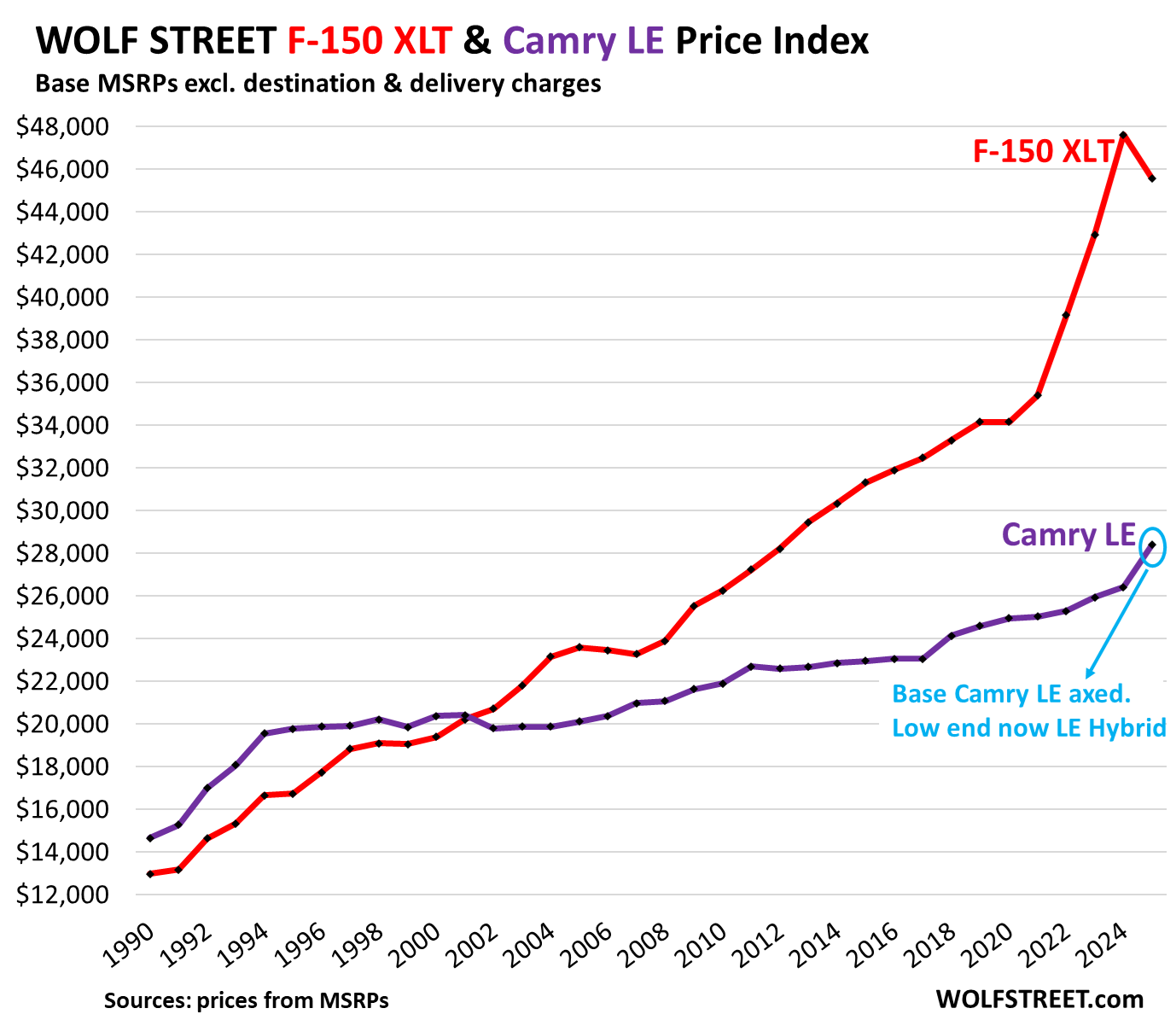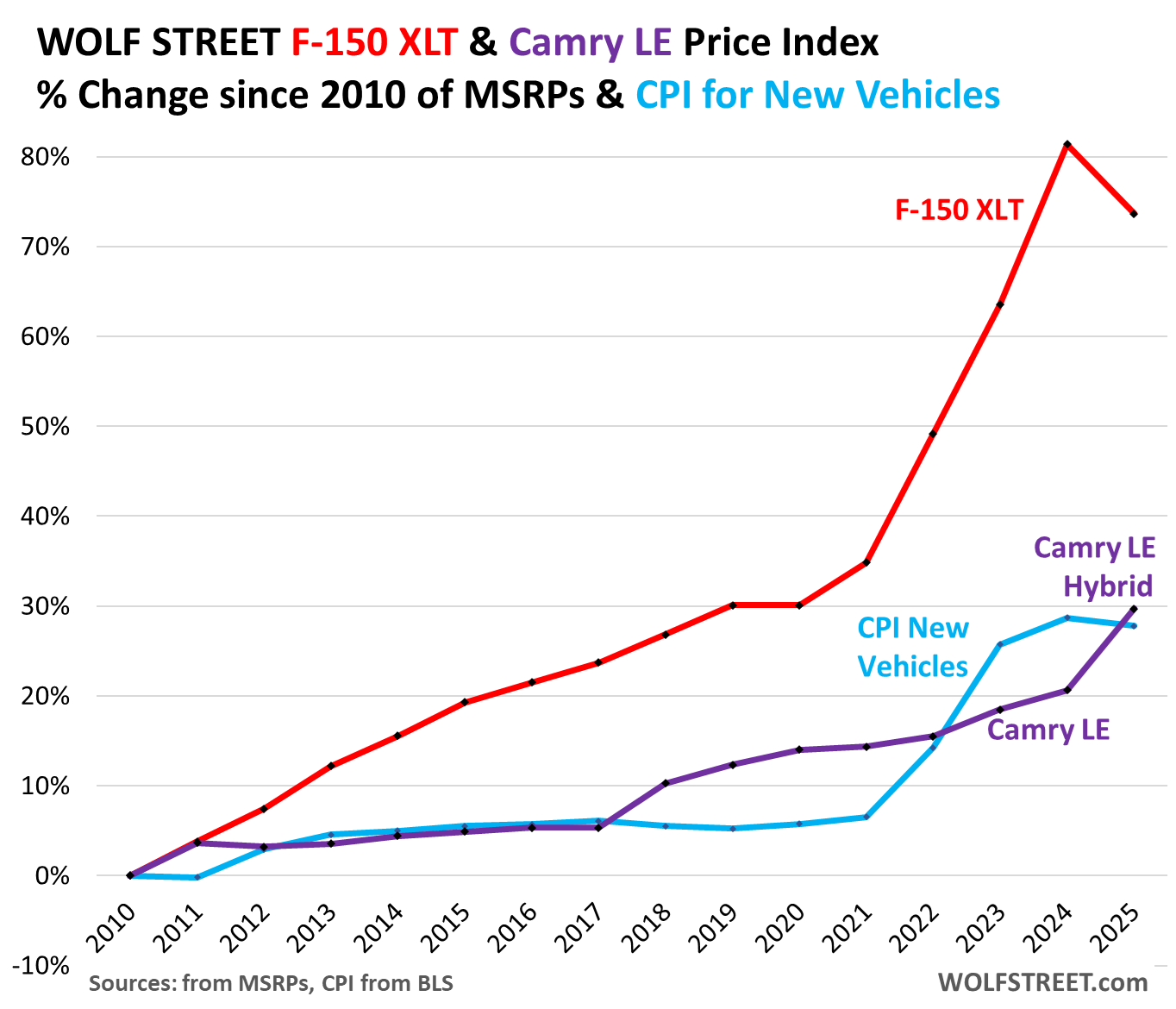 [[{“value”:”
[[{“value”:”
Ford cuts truck prices after grotesque increases in prior years. Toyota axes the base Camry; new base Camry is a more expensive hybrid.
By Wolf Richter for WOLF STREET.
It’s this time of the year again: Ford is starting to build the 2025 F-150 this week, and final prices are posted on its website. What’s different this year is that, after the obscene price increases in the prior two model years, Ford cut the MSRP for its 2025 trucks. The MSRP of the two-door, rear-wheel-drive, base-everything F-150 XLT was cut, cutely, by $2,025, to $45,595, from last year’s $47,620.
That magnitude of price cut, in dollar terms and in percentage terms (-4.3%), has never before happened in the price index going back to 1990. But Ford jacked up prices by a grotesque 35% over the prior three model years, and the price cut only rolls back a small portion of these obscene price increases.
Toyota sort of went the opposite direction with its 2025 Camry: It axed the base model Camry LE that formed the data points in the WOLF STREET F-150 XLT & Camry LE Price Index going back to 1990. The new base version is now the Camry LE Hybrid, which last year was a $2,400 option, and now it’s the minimum low end you can buy. So there is a $1,980 price increase in the MSRP of the base Camry this year, to $28,400, from the base Camry last year of $26,420. But you get a hybrid even if you don’t want one.

In the 1990s, when trucks were still reasonably priced, the Camry LE was more expensive than the F-150 XLT. But by the 2000s, automakers started turning trucks into a higher-end product, and by the 2024 model year, the F-150 was almost twice as expensive as the Camry LE, and Americans were playing along because they like big equipment and generally don’t mind paying out of their nose for it. But there are limits.
As pickups got way too expensive in recent years, with huge profit margins for automakers and dealers, sales stalled and inventories are now piling up. This year, sales have to be stimulated with massive incentives. So Ford is doing the right thing by cutting MSRPs, but the cuts from the grotesque spike in the prior two years may not be enough.
Total MSRPs are even bigger. These MSRPs in our index do not include Ford’s “destination and delivery” charges of $1,995 (same as last year) and Toyota’s “Delivery, Processing and Handling” charges of $1,135 (up from $1,095 last year).
Including the charges, the total MSRP of the base F-150 XLT declined to $47,590 from last year’s $49,615. And the total MSRP of the Camry LE rose to $29,535, from the base Camry LE last year of $27,515.
The CPI for new vehicles, which we compare to the prices of the Camry LE and F-150 XLT, after exploding in the prior three years, fell back a little over the past 12 months, tracking the real-life issue of new vehicles having gotten too expensive, with sales hitting resistance, and inventories piling up. To stimulate sales, automakers and dealers have piled on massive incentives and discounts. The CPI for new vehicles, which tracks the purchase prices paid by customers, did a pretty good job tracking this.
The CPI for new vehicles has been tracking the Camry’s price developments pretty closely since 2010, but rose faster than the Camry model years 2023 and 2024. For the 2025 model year, we no longer have the same base model of the Camry, and the new base model that is now a hybrid is more expensive than the prior base model.
Since 2010, the CPI for new vehicles has risen by 27.8%, outrunning the price increases of the Camry LE through the 2024 model year (+20.6%).
But the upgrade of the base Camry to the hybrid pushed the Camry’s rate of price increases since 2010 to +29.7%, above the rate of increases of the CPI.
Since 2010, the MSRP of the F-150 XLT has risen grotesquely by 73.7%, despite the cut this year.

We use the base F-150 XLT and the base Camry LE for two reasons: One, because both go back beyond 1990; and two, because both have been bestsellers in their categories, true mass-market vehicles. Other models, such as the Corvette or the Mustang, go back even further, but they have never been mass-market vehicles.
Toyota killed our price index, but it lives on. The 2025 upgrade to a hybrid powertrain makes the base Camry a different model, in a different price category, and it is no longer comparable to the prior base Camry. With this shift in models, Toyota killed our price index. Nevertheless, it lives on, because stuff happens, technologies change, cars get better, Ford trucks now come with a base 10-speed automatic transmission with hybrid still optional, and life goes on. So there!
Obviously, MSRP is not the price buyers actually pay. In 2021 and in 2022, during the time of the shortages, dealers sold trucks with odious addendum stickers on top of MSRP. People should have walked out and wait a couple of years before buying. Some did, many paid the addendum stickers on top of MSRP. Now trucks, with dealer lots full of them, are selling for large discounts off MSRP. But we use MSRP as a common thread in the index over the three decades, even if people paid more or less for their vehicles.
Enjoy reading WOLF STREET and want to support it? You can donate. I appreciate it immensely. Click on the beer and iced-tea mug to find out how:
Would you like to be notified via email when WOLF STREET publishes a new article? Sign up here.
![]()
The post Our F-150 XLT & Camry LE Price Index, Going Back to 1990, Is Updated with 2025 Model-Year Prices. There Were Some Twists appeared first on Energy News Beat.
“}]]

